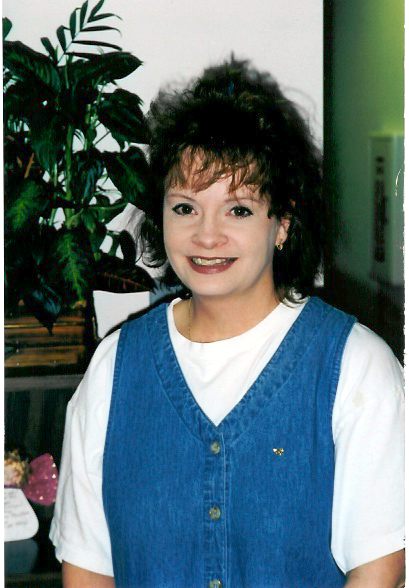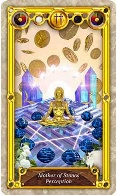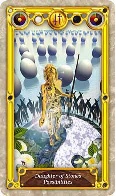
Sheila Hall has been studying the Tarot for
16 years. She has just received her CTM certification and is currently
working towards her CTI. Sheila is an ATA mentor, reading on both the
Free Tarot and Free Reading Networks, and also serves on the ATA
Education Committee. She lives in Tennessee with her husband and two
sons.
|
|
 |
The Quest Tarot is a
deck created with 3D computer graphics. The images are colorful,
sharp, and vivid. The deck includes two additional cards. One card is
blank, which allows you to personalize a card for yourself. The card
is not completely blank. It has the layout like the rest of the cards.
The next additional card is entitled "The Multiverse," with the
keyword being "Unbound."
The deck includes some unique features, right on the card. One of the
features deals with asking Yes/No type questions. Let's face it -
there are times when we would really like a simple Yes/No answer. Some
readers develop their own system to find these types of answers, while
others will not ask Yes/No questions, but try to find an alternative
way to ask the question, and derive an answer that is helpful and
guiding. |
Working with the symbol of two swords, placed at the top of the court
cards only, you have the possibility of four different answers for Yes/No
questions. The answer can be "Yes, No, or Maybe." The "Maybe" tells us
that the answer "Lies In The Past or The Future," depending on the
direction in which the swords are pointing. This system seems quick,
clear, and simple.
Another feature is in being able to foretell time. Telling time is another
system that a lot of Tarot readers have worked to create for themselves.
The Aces include a clock on the upper left corner. Each clock covers a
three-month period, which is marked by certain numbers in red, and helps
us to determine "actual months and time periods." The Aces also include a
small picture on the upper right corner showing the season for each Ace.
The book discusses the way to calculate this option in detail.
|
|
Tarot
readers are asked all types of questions during readings. We are asked
questions like: "What is the name of the person I will marry?", "Who is
gossiping about me?" and the list could go on and on. The Quest Tarot deck
provides us a way to shed some information on these types of questions,
too. The deck includes the letters of the Roman alphabet enclosed in small
circles on the card. The letters are included on almost all the cards, and
the cards without letters are considered wildcards, which can be used to
fill in the gaps of letters that are not present when you select cards
after asking the question. You pull one card for each word in the
question, and then begin by piecing the letters together to form words.
Curiosity got the best of me and I had to try this feature out to see if
it would work. I asked the question "What is my younger son's name?" I
then followed the directions and drew six cards. One card for each word in
my question. I received the letters j, n, h and the rest were wildcards.
My youngest son's name is Noah, so I was able to use the n, h and the
wildcards for the o and a. I chose another question, and received four
cards with letters that I was able to use again. I have to admit I was
quite surprised that this worked. The book shows you how to use the Yes/No
and Spelling Words features together.
The physical traits of people are also enclosed in circles on the card.
Hair, eye, and skin color are included on the Court cards. A problem that
I have with this is that not all these correspondences work for me, but
may for others.
The cards also have the following symbols placed on them:
Hebrew Letters
Rune Stones
I Ching Hexagrams
The cards have numbers on the top center, and the title at the bottom,
along with a keyword. Most of the listed keywords listed on the cards
relate well. The card Alchemy, is renamed for Temperance, Aeon for key 20,
and The Universe for key 21. The Minor Arcana suits are Wands, Cups,
Swords, and the Pentacles suit is called Stones. The Court cards have
different titles, and are listed with the feminine cards before the
masculine. I like the new titles, and as Martin states, "we no longer live
in a social structure of kings, queens, knights, and pages." I agree, and
believe that people who have trouble with Court cards may find these
titles easier to relate to.

Father of Stones |

Mother of Stones |

Son of Stones |

Daughter of Stones |
The astrological correspondences are included on the cards as well. The
book covers these correspondences with a discussion of each card and
includes the pictorial glyphs for the signs, planets, and shows where they
are located on each card. The correspondences follow along with the Golden
Dawn tradition, except for the Nine of Wands, which has the Sun in
Sagittarius, in place of the Moon. The Moon is left out of the Wands
associations completely.
The book entitled, "The Compass Guide To The Quest Tarot" is the 296-page
companion guide. It begins by covering the topics of "How to care for your
cards," which includes items needed, such as cloth, box, etc., a card
purification ritual, and even goes into what to wear during a reading.
The book includes charts listing the correspondences of gemstones for
months, signs, planets, including mythic and Ayurvedic birthstones. Each
card is further discussed in more detail in the last part of the book.
Each symbol or feature that I have mentioned has its place on the cards.
The symbols are enclosed in small circles and are placed across the top of
the card, along the sides, and at the bottom where the title is located.
The symbols, representing the different correspondences for each card, are
easily visible. They form a border around the image. The 3D computer
images are stunning, but the border makes the images smaller.
The book includes a section for Tarot party games. Eight games, along with
the rules, are discussed. Tarot games are fun to play at parties. Three
card spreads, the Celtic Cross, and the Quest spread are covered in the
book. The Quest Tarot spread helps you to take a look at where you have
been, where you are now, and where you are heading, long with the people
involved, and guidance that is being offered. I liked working the Quest
Spread. A spread sheet is included, in the shape of the Celtic Cross. You
can make enlarged copies of it to use with your readings.
I feel that the creator/author has worked to develop a well-defined deck
that includes all the systems of correspondences that readers like work
with. Usually decks incorporate one or two associated correspondences, and
we can work at incorporating our own systems that we like to use. The
thoughts, work, and considerations for this are greatly appreciated. I do
believe that he stresses certain ways to work with the cards a little too
strongly. One way of doing things does not work for all people. One
example can be the suggested shuffling method. I've spent time in working
on a shuffling method that works and feels comfortable to me.
The Quest Tarot has exciting images to read with. The images have a lot of
symbolism within them, besides all the little circles for correspondences
that border them. I do find that, for beginners, all of the
correspondences on the card can be easily accessible, but also
overwhelming. Some beginners feel overwhelmed by having to learn the
meanings of 78 cards in upright and reversed positions, already.
However, the Quest Tarot does offer a complete system to learn with.
Intermediate and more advanced readers will find the included
corresponding associations on the cards as helpful reminders, and may also
encourage us to work with a system that we may have not considered before.
You can try an online
reading with the Quest Tarot. If you like it, you can
order the deck from Llewellyn Online, or directly from
the creator's web site.
The Quest Tarot was created by Joseph Ernest Martin, and is published by
Llewellyn, ISBN: 0-7387-0195-5.
|






